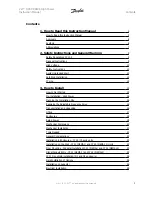
Chapter 3 Arbitrary Waveform Output
DG4000 User's Guide
3-13
points and be lower than or equal to X2.
Y1: Set the voltage of the start point in mV or V. The setting range of
voltage is limited by the "
HiLevel" and "LoLevel".
X2: Set the ID of the end point of the block (namely the time position of
the end point). X2 should be lower than or equal to the number of initial
points and be greater than or equal to X1.
Y2: Set the voltage of the end point in mV or V. The setting range of
voltage is limited by the "
HiLevel" and "LoLevel".
Execute: Edit the points between the start and end points according to
the current setting.
Delete: Delete the points that can be edited between X1 and X2 and
connect the start and end points using the current interpolation method.
Note that the first waveform point and the last waveform point cannot be
deleted.
8.
Save
The currently created waveform is stored in the volatile memory by default. If
the memory already contains waveform data, the previous waveform data will
be overwritten.
Press
Save to enter the file storage interface and you can store the waveform
created in the internal non-volatile memory (C Disk) or external memory (D
Disk) (refer to "
Tips
Users can also use the PC software to edit arbitrary waveform; then, use the
SCPI methods to store the waveform in the internal memory or external
memory of the instrument (for the detailed method, refer to
DG4000
Programming Guide
).
*SAV ARB1|ARB2|ARB3|ARB4|ARB5|ARB6|ARB7|ARB8|ARB9|ARB10
Store the waveform to the internal non-volatile memory of the
instrument.
:MMEMory:STORe <file_name>
Store the waveform to the external memory (USB storage device) of the
instrument.
Summary of Contents for DG4062
Page 2: ......
Page 14: ...RIGOL XII DG4000 User s Guide...
Page 92: ......
Page 128: ......
Page 140: ......
Page 150: ......
Page 210: ......
Page 213: ...Chapter 11 Remote Control RIGOL DG4000 User s Guide 11 3 3 4 5 6...
Page 218: ......
Page 222: ......
















































